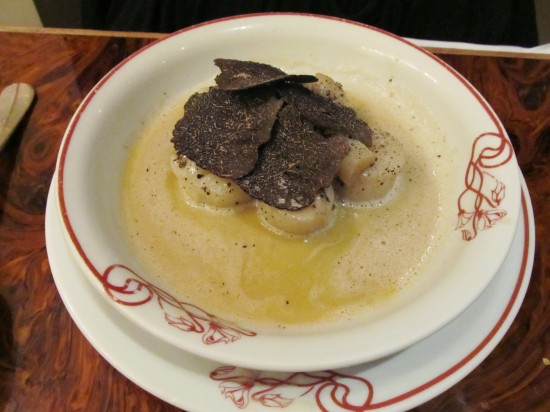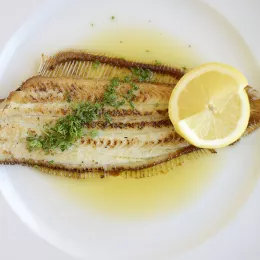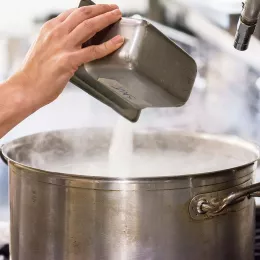At least once every decade some culinary pundit or self-appointed expert on cuisine and gastronomy makes a grand pronouncement declaring the "death of French cuisine". This has been an ongoing trend in culinary journalism since as far back as the late 19th century. Whether it was the fall of the classical grande cuisine of Carême, Escoffier and Du Bois or end of the nouvelle cuisine revolution that shook France after from the 1950s to the 1980s, the state of French cuisine has always been ripe for debate.

Yet there seemed to be a significant shift somewhere around 2003, when the New York Times ran a front-page story in its Sunday Magazine declaring — once and for all — the death of French cuisine. The piece went on to anoint Spanish chef Ferran Adria as the "pope" of contemporary gastronomy (called molecular or modernist, depending on who you asked). However, upon a recent trip to Paris, it was apparent that the death notices (as usual) are premature.
The wild card in the whole discussion is the profound influence — encoded in the DNA of the French people — of the cuisine bourgeoise: the cooking of French housewives and grandmothers, rooted in the terroir of local ingredients and traditions. In the context of restaurants, this cuisine has transformed itself into a movement labeled bistronomie, a trend that snubs the grande luxe dining palaces with their fine china, sterling silver place settings, starched linens and snooty waiters, maitre'ds, and sommeliers (who act as if the customer is there to serve them, not the other way around).
Here the cuisine of grandmère and maman rears its beautiful head — in simple preparations based on a market-driven cuisine with an emphasis on seasonality, solid culinary technique, unpretentious presentations and friendly, relaxed knowledgeable service.

Like any so-called revolution, politics, and economics are among the underlying forces that have dictated this change in French cuisine, gastronomy and food culture. With the volatility of the "euro" and the global economic crisis, it is now more cost-prohibitive than ever for a business owner to sustain luxury operations in the long-term. It has become economic suicide to maintain a brigade of forty to fifty chefs, cooks and other staff (in the back of the house alone), uphold a large inventory of grand cru wines, and support the various other elements of leasing or owning a space that would fit the traditional Michelin definition of three stars.

Complementing this transformation in the kitchen is a social and literary movement, one that has rallied in particular behind France's modern response to the long-reigning Michelin Dining Guides. Founded in 2000 by Alexandre Cammas, "Le Fooding" springs from a curious mix of anti-corporate left wing politics and social libertarianism, and it poses a direct challenge to the moribund culture of Michelin and its dominance over French cuisine for more than 100 years.
The first "Le Fooding" guidebook was published in 2006, and the movement has since jumped the Atlantic, holding annual events in New York City — incidentally, taking place this weekend in the Rockaways. It's particularly fitting that "Le Fooding" should also celebrate NYC's dining culture, as many of the restaurants that my wife Cheryl and I visited in Paris would fit in very comfortably (thank you) in neighborhoods such as the Lower East Side, Williamsburg or Long Island City. Below are some of the best examples of this "new/old" cooking that we discovered — fusing la cuisine bourgeoise with chef-level consistency and innovation.

L'ASSIETTE — Rue du Chateau in the 14th arr.
Chef/owner David Rathgeber's cuisine is deeply rooted in culture of his homeland of the Landes region of Southwest France, but his technique was honed for 10 years under the renowned Chef Alain Ducasse. On the night we dined at this restored 1930's boucherie, we savored his house-cured country ham with homemade farm bread and beurre demi-sel, foie gras terrine with a conserve of figs, and rillettes of suckling pig and foie gras. There was warm, poached asparagus with an incredibly silky sauce mousseline; sea scallops poached in champagne with a nage of black truffles and melted leeks; stuffed calves head, sauce ravigote and what could only be described as the most ethereal sea salt crème caramel one could possibly taste.
CASA OLYMPE — Rue St. George's in the 9th arr.
Olympe Versini is an icon among female chefs in Paris, receiving her first Michelin stars when she was only in her twenties. She is considered to be "the godmother" of this new trend in French dining, as when she opened Casa Olympe in 1993, she asked the Michelin inspectors to stay away and not review the restaurant. Her food is profoundly influenced by her Corsican ancestry and the Mediterranean basin. If available, try her blood sausage croustillants on mesclun greens; warm salad of seared scallops, house-cured foie gras, avocados, and mâche; daurade roasted on the bone with tomatoes, lemon, potatoes, herbs and olive oil; perfectly roasted squab with Asian spices and Thai red rice-coconut milk pilaf.

LE COMPTOIR DE RELAIS — Place d'Odeon in the 6th arr.
Chef Yves Camdeborde has been the leader and vanguard of bistronomie for the past 20 years in Paris. He worked for many years with his mentor Christian Constant at the Hotel de Crillon, where they elevated the cuisine of the Restaurant les Ambassadeurs to two Michelin stars. His extensive menu is available at lunch, but be forewarned — no reservations are accepted and the restaurant fills up by 12:30 p.m. It is virtually impossible to get reservations at dinner when the menu becomes a prix fixe of fifteen courses. Dishes that I can highly suggest are the unusual warm terrine of boudin noir with a refreshing salad of celery root, apples and sucrine lettuce; salade gourmande of salt-cured foie gras, green beans, artichokes and potatoes; smoked pork belly, braised slowly and served with a reduction of the braising jus and a nicoise olive-potato purée; pan-fried stuffed pigs feet and a warm individual apple tarte with vanilla ice cream and salted caramel.
LES COCOTTES — Rue St. Dominique in the 7th arr.
Christian Constant, mentioned above, left the Hotel de Crillon years ago to establish his own restaurant group, which includes Les Cocottes. The restaurant is known for its casual counter seating, large menu of wines by the glass and hot menu items — all of which are served in deep cast iron cocottes produced in Alsace. Our starters included Spanish jamón ibérico simply served with pickled piquillo peppers; an outstanding ravioli of langoustine with artichoke purée and shellfish coulis (that resembled a shellfish cappuccino more than a classic sauce); impeccably seared scallops on parmesan polenta with a light reduction of jus d'opulent roti; and wood pigeon roasted with a ragoût of spring onions, honey mushrooms and chestnuts, simply sauced with a reduction of the roasting juices. One quick note about the wines we drank: one does not have to break the bank to drink reasonably well in Paris. Stick to the regional wines with A.O.C. certification and you can enjoy excellent wines for less than thirty Euros a bottle.
Craving more culinary travel stories? Check out Chef Ted's guide to Rome.




